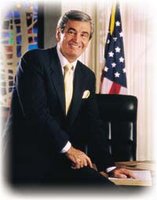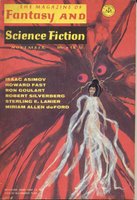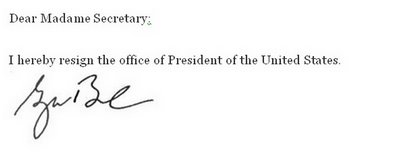 Or hadn't you noticed?
Or hadn't you noticed?
We are an empire now, and when we act, we create our own reality. —The Bush administration
The conservative moment is over. The experiment has failed, crashing down in the face of reality. The Republican Congress and the Bush White House set themselves up in opposition to the most basic truths in a display of hubris that historians will puzzle over forever. Even arithmetic is the enemy of today's shameless scions of the conservative legacy: Tax cuts and spending increases do not add up to a balanced budget. Such a surprise.
Not long ago it seemed that reality was more unpopular in the progressive community. Leftists like
Alan Sokal decried the tendencies of his political allies to fall prey to extreme social constructivism: everything is relative, truth is personal, and objectivity is only a myth. Sokal famously demonstrated the willingness of the anything-goes crowd to swallow the most absurd nonsense by expressing New Age cant in the language of physics and getting it published. His lesson was that critical thinking should never go out of style. Who knew that our political opponents in the hard-headed conservative movement would turn out to be the wackiest postmodernists of all?
Nothing exemplifies this reality drift better than the GOP's behavior in Congress. The long-entrenched Democratic majority in the U.S. House of Representatives was dramatically ousted in the general election of 1994. The Republican “
Contract with America” promised a series of good-government reforms, but in merely a dozen years the GOP majority has descended to a level of sleaze that exceeds anything the House Democrats managed in their forty-year reign.
Texas Democrat Jim Wright was Speaker of the House in 1989 when he was hounded from office for corruption. He was accused of bundling his old speeches in book form and selling them in bulk to circumvent limits on speaking fees. Wright was also said to be evading the limits on gifts by directing the contributions through a job his wife had. Wright's case was an example exploited by the GOP in the 1994 elections. Today we have California Republican John Doolittle, a member of the House leadership, directing campaign contributions through a company headed by his wife; she skims off a 15% commission (for no discernable work) before the contributions go into the congressman's political fund. Doolittle, however, isn't resigning in disgrace. No, he's running for re-election. Times change.
One of the planks in the Contract with America was fiscal responsibility. With the nation under the stewardship of a moderately liberal president, the House Republicans were even able to enact a balanced federal budget. However, once Bill Clinton was succeeded by George W. Bush, the doors of the candy shop were flung open and the U.S. plunged into a spending spree from which we have yet to emerge. The betrayal of conservative principles of management has been so dramatic that more authentic conservatives have felt compelled to speak out. The book
Impostor by Bruce Bartlett is one notable example; in case you didn't know, George W. Bush plays the title role.
Can the conservative moment come to an end without a liberal resurgence? Some of us appear to be standing quietly by the sidelines in the hopes that the GOP implosion will continue unabated. We'll stroll in once the self-destruction is complete. That passive approach, however, could leave us holding a very empty bag. The conservative collapse is an opportunity, but mandates must be earned. To that end, liberals need to prepare themselves to take command.
The progressive on-line community is already marshaling its troops. We fell short in 2004, but that simply heightens the importance of not failing again. The nation pays a price every day that the Bush administration continues with its mendacity-based domestic and foreign policies. The truth campaign is under way, as exemplified by such manifestos as Chris Mooney's
The Republican War on Science and
Crashing the Gate by Jerome Armstrong and Markos Moulitsas Zúniga. Get both and get ready to be part of it.
There is work for everyone to do. What will your role be? While I am only a bit player myself, I do have a story to tell. Today I'm a math teacher who ventures in from the political sidelines occasionally to write a letter to the editor, e-mail a candidate's campaign, pony up some contributions, and participate in local rallies. (I'm tall. At one rally a campaign aide gave me the job of holding up a large sign between some banner-waving half-drunk GOP frat boys and the TV cameras. It was fun.) Before getting my faculty appointment, however, I served under the golden dome of the California state capitol as a legislative aide. I watched who pulled the levers of power and I saw some of the techniques they used. These people are accessible by citizens who take the trouble to learn some things about the system and how to work it.
Let me share that with you. First, I'll give you an example of pure serendipity, an infamous story in my academic discipline. After recounting my own initial encounter with the legislative process, I'll generalize a bit and suggest that you, too, can play the part of our humble protagonist.
 A wedge of pi
A wedge of pi
Clarence Waldo did not usually spend his days at the Indiana state capitol building. A professor of mathematics at Purdue University, Waldo was checking in on the progress of an appropriation earmarked for his school. On this occasion in 1897, however, Professor Waldo unexpectedly found himself acting on his mathematical expertise and not just lobbying on behalf of his university's special interest.
House Bill No. 246 offered the state of Indiana the right to use a new and improved value of pi in its public schools—royalty free! Schools in other states would presumably have to pay a consideration and apply to Dr. Edwin J. Goodman (a physician) for permission to use his new value of pi. The debate in the Indiana State Senate was in full swing when Professor Waldo happened to look in, much to his surprise. The State House of Representatives had already passed Bill No. 246 unanimously. Waldo buttonholed some legislators, explained what they were on the verge of doing, and succeeded in getting Bill No. 246 sidetracked. On its second reading in the State Senate, the measure was “indefinitely postponed”; Bill No. 246 languished in the senate's suspense file until it died at the end of the legislative session, never more to be seen or acted upon.
Professor Waldo fell accidentally into the role of citizen lobbyist. His story illustrates how technical expertise in the right place at the right time can nudge the behavior of a legislative body. The story of Indiana's pi legislation shows us what one person can do, but in one significant aspect it fails as a cautionary tale. Bill No. 246 was ultimately trivial and it would soon have been ignored and forgotten had it been enacted into law. Today we face issues of science and technology that could powerfully shape what we learn in school, how our environment will change, and the resources we need to live. We need to find Waldo's successors, but too few of us are inclined to take up the challenge.
We live in the world that government makes for us, whether we participate in that government or not. It's time to participate—and we know where the need is.
 Legislators don't know science
Legislators don't know science
It was the late seventies. As the first mathematician with a
California legislative fellowship, I expected that my services would be eagerly sought. My experience during the placement interviews taught me otherwise. I quickly learned that the legislators and their staffs didn't know what to do with me. An aide to the chair of the reapportionment committee said, “Well, we do use a lot of numbers.” My training as a problem-solver was assumed to be limited to
number-crunching. Eventually, though, I landed in the office of a senior legislator whose staff showed more savvy. One aide laughed at the notion that his counterparts in so many of the other offices thought I wanted to sit and solve math problems all day: “It just seems to me that if you apply for a job in a butcher shop, you must be looking to cut some meat!”
I then proceeded to “cut some meat” for the next couple of years. It was the real beginning of my education in the sausage factory that is our form of government. It wasn't always pretty and it wasn't always important, the bills that were debated and the laws that were enacted, but some of the measures dramatically affected the way of life of millions of California residents (both for good and for ill).
My boss was a classic liberal who thought it was the government's responsibility to protect the rights and freedoms of the individual against the disproportionate power and influence of giant special interests. He held a Ph.D. in history from Stanford and had been a college professor before his election to the legislature. He was one of the last of a vanishing breed.
The gentleman scholar in the mold of Thomas Jefferson no longer appears in the legislative or executive ranks. Although my boss would be embarrassed beyond words to be compared to Jefferson, it is entirely fair to say that he was a man of ideas who was accustomed to thinking things through. As a professor, he had put in many hours expounding on history, political science, and economics, discussing the issues with his students. Today's politician is more likely to pore over the latest poll results than read a treatise on, say, the role of regulation in a free economy. A modern politician's expertise lies in getting elected. All other expertise is relegated to staff aides and consultants.
Very few scholars are elected to public office. In particular, there are virtually no scientists serving as state or federal representatives. Successful scientists, of course, are much too busy applying for grants, doing their research, and writing their papers. Running for office would involve giving it all up. People with science training who don't pursue research careers can find more lucrative careers as consultants in the business sector than as candidates for office. A few may, of course, serve as consultants on legislative staffs, but we're still talking about a relatively small number. I knew good people in California's Senate Office of Research, but they had to keep up with the demands of forty state senators and their legislative committees and staff.
Those who know science best are largely outside the process by which science is funded, regulated, and promoted. The end result is that policies strongly affecting pure and applied research are informed more by political considerations than by standards of scientific excellence. Nowhere has this made more clear than in the wrong-headed federal approach to
stem cell research,
global warming, and
energy resources.
These and other crucial topics in health, education, and welfare underscore the degree to which our potential problems mandate the effective use of government policy to address them. Problems of such broad scope require collective rather than individual action. Government is the instrument for joint action, which is why we cannot ignore it even if we disdain its excesses. The government is controlled by those who bother to take part in it. We cannot surrender it to the know-nothings.
 A primer on the three C's
A primer on the three C's
Most states have laws regulating the activities of professional lobbyists, but citizens always have a right to petition their government. If you operate without pay, you do not fall under these regulations. (Just to be safe, you can check what activities fall under your state's rules by checking into your local equivalent of California's
Fair Political Practices Commission.)
Anyone who wants to be successful as a citizen lobbyist should keep three key ideas in mind:
Context: Opportunity knocks at unexpected times, so you have to be alert as circumstances change. I once took advantage of the national frenzy over our bicentennial in 1976 to promote in the California legislature the bicentennial of a famous mathematician's birth. In the wake of the fireworks and celebrations to commemorate our 200th year as a nation, it was easy to draw legislators' attention to another bicentennial and get a resolution adopted in the mathematician's honor. When the resolution was featured in a regional newspaper, one of my math professors said, “Is this how the news really happens?” Yes, it is. (And I think it later led to my fellowship at the state capitol.)
Right now northern California has been drenched by a continuous stream of rainstorms, wreaking water damage and threatening levees across the state. It's the perfect time for hydrologists and civil engineers to help their legislators understand what the priorities are, and how best to achieve them. Left to themselves, the legislators don't know. Some of them will simply believe the last lobbyist they talk to, particularly if the lobbyist represents a good source of campaign funds. We have seen especially egregious abuses in the House of Representatives, where the Republican leadership has permitted special-interest lobbyists to write the bills that regulate their own industries. (This is not exactly an innovation. Remember the scene in
The Aviator where Pan Am's lawyers provide the language of a senate bill to regulate airlines?)
 Content:
Content: In the example of the Indiana legislation on pi, the text of the measure was far beyond the mathematical ability of the typical legislator. (In reality it was also beyond that of Dr. Goodman, the sponsor, but that's beside the point.) If the bill's sponsor had not been willing to provide the content of the bill, it would never have been introduced. When an informal advisor to a legislator does the work of providing the language and details of a needed bill or policy, that bill or policy is much more likely to be considered for action. When I sponsored a resolution in the California legislature, the entire body of the measure was cribbed from the proposal I submitted to my state senator and state assemblyman.
Perhaps you know a technical issue in great detail and want to lend your expertise to a legislative solution, but you don't know how to frame it in language that could be incorporated in a bill. That's when you look around for allies, because there are public-interest groups in most areas of concern. If you have mastery of the technicalities, you can work in concert with someone who knows the right words and forms to use. The citizen lobbyist doesn't have to do it all alone.
Credit: The famously liberal Ronald Reagan is reputed to have said, “You can get a lot done in this town if you don't care who gets the credit.” The citizen lobbyist seldom gets any credit for his or her efforts, but that's okay. Your real concern is to get things done. The credit can go to whoever's name is on the piece of legislation that gets enacted into law or the policy that gets announced. What's more, if you're not trying to elbow your way to the front of the crowd, your work will gain credibility. Legislative halls are full of people who want to take credit for stuff. Some of them will regard you as a mark to be taken advantage of when you do most of the work and get none of the acclaim, but you're operating according to a different standard. Success is what counts.
My boss in the state legislature was famous during his tenure in the state senate for his success at shepherding legislation into law, but the truth is that many of his greatest accomplishments carried the names of his colleagues rather than his own. He was a master of the rival bill, a measure introduced to promote his approach to a state issue even when the issue was supposedly “owned” by a colleague. The colleague would keep an eye on my boss's bill, frequently cannibalizing it bit by bit, incorporating its language into his own bill until my boss would pronounce himself satisfied and quietly drop the rival measure. Many statutes in the California code books contain my boss's words but some other legislator's name.
Remember, success is what counts.
Further reading: The sad tale of Indiana House Bill No. 246 is told in
Legislating Pi, a chapter of Underwood Dudley's
Mathematical Cranks. Dudley points out that Dr. Goodman's definition of pi was so confused and contradictory that it is not possible to tell from the language of the bill (which Goodman undoubtedly wrote) what value he intended. Petr Beckmann gives a detailed accounting of Professor Waldo's successful lobbying in
A History of Pi (see chapter 17,
The Modern Circle-Squarers). Former California state senate president pro tempore James R. Mills wrote a book about the crucial Brown-Unruh years in state politics. Its title is
A Disorderly House and it's out of print, but used-book sellers can easily get it for people who want to know more about California politics from an insider's perspective. Jesse M. Unruh, for whom I was privileged to work in the 1980s when he was state treasurer, presided as speaker of the assembly during the creation of the professional staff system that still supports the work of the California legislature. In an era of term limits, Unruh's staff system now has more continuity and collective expertise than the legislators who rapidly cycle in and out of the state capitol.
 Through a glass snarkly
Through a glass snarkly Bearing false witness
Bearing false witness










































